70. AI Adoption in Fashion Retail: 7 Change Management Strategies to Overcome Resistance
AI is reshaping the retail fashion industry – from predicting trends to personalizing customer experiences – but technology alone doesn’t guarantee success. The real game-changer? How effectively a company manages the people side of AI adoption. In this article, we explore why employees at global fashion retailers might resist AI-driven change and outline 7 proven change management strategies (with real-world examples) to turn resistance into enthusiasm. Corporate executives will find actionable insights on leading their teams through an AI-powered transformation in the highly competitive world of fashion retail.
Q1: FOUNDATIONS OF AI IN SME MANAGEMENT - CHAPTER 3 (DAYS 60–90): LAYING OPERATIONAL FOUNDATIONS
Gary Stoyanov PhD
3/11/202522 min read

1. Understanding Resistance to AI in Fashion Retail
1.1 Why Employees Resist Change
Change is hard, especially in an industry steeped in creative tradition. Fashion retail employees often fear that AI could make their skills or roles obsolete. For example, when H&M introduced AI for buying and inventory decisions, its purchasing team initially “decried the move – and then resisted it,” feeling that an algorithm was encroaching on their expertise.
This fear of the unknown – “Will I lose my job or status to a machine?” – is a common driver of resistance. Additionally, many fashion companies have veterans who are deeply accustomed to legacy processes (“we’ve always done it this way”). Such ingrained habits breed skepticism towards new, data-driven approaches. There’s also a cultural element: fashion has long been driven by human creativity and intuition. The introduction of AI can be perceived as a shift toward a cold, analytical style that might clash with the brand’s creative ethos. In short, resistance often boils down to fear (job security, role change), habit (comfort with status quo), and identity (tech vs. creativity culture). Recognizing these root causes is the first step in addressing them.
1.2 The Cost of Ignoring Resistance
Failing to address employee resistance can derail even the most promising AI initiatives. Research shows that organizations with employees who personally see value in new tech are nearly six times more likely to achieve significant benefits from AI than those where staff don’t see the value.
Conversely, if resistance runs rampant, adoption stalls – meaning a retailer might invest millions in an AI platform that nobody uses effectively. Consider a cautionary scenario: a fashion brand implements an AI-driven styling recommendation tool for store associates, but employees distrust the suggestions. They stick to the old way of manually recommending outfits, and the AI tool sits underutilized. The result is lost ROI and a frustrated leadership wondering why the tech “didn’t work.”
Furthermore, morale and retention can suffer. In a high-turnover industry like retail, talented employees may leave rather than adapt if they feel threatened or unsupported during the transition. The bottom line: unaddressed resistance leads to poor adoption rates, wasted investments, and an organization that is slower to respond to market changes. For fashion retailers eager to stay ahead, that’s a risk not worth taking.
2. Laying the Groundwork: Make the Case for AI
2.1 Align AI with Business Vision
The first strategy in change management is creating a clear and compelling vision that ties AI adoption to the company’s broader goals. Employees need to understand why the change is happening. Is it to improve customer experience?
To streamline operations and stay competitive? Executives should communicate, for instance, “We’re implementing AI in our supply chain to ensure our stores are always stocked with the styles you love – no more missed sales or markdowns.” When Nike launched its Consumer Direct Offense strategy in 2017, it was described as “a new company alignment” focused on digital channels and data-driven decision-making.
This top-down clarity signaled to every employee that AI and analytics were now core to Nike’s mission of serving customers “more personally at scale”. Similarly, luxury brand Burberry framed its digital investments as central to maintaining its iconic customer experience in a changing world. By aligning AI projects with a vision everyone can rally around, you turn a potential source of fear into a shared ambition. Employees are more likely to support change when they see how it secures the company’s future and, by extension, their own.
2.2 Executive Sponsorship and Role Modeling
Even the best vision needs champions. Strong executive sponsorship is critical – leaders must visibly back the AI initiative and also model the behaviors they expect. This means leaders not only talk the talk but also embrace new tools themselves. If a CEO expects store managers to use a new AI dashboard for merchandising, the CEO and senior team should reference insights from that dashboard in meetings, signaling its importance. At one global fashion retailer, the CIO and Head of Merchandising co-hosted weekly update meetings on the progress of an AI-driven inventory system.
They celebrated small wins and openly discussed challenges, demonstrating commitment and transparency. When executives engage like this, it sends a powerful message: “This change has our full support, and we are in it together.” Moreover, having respected figures in the company advocate for the AI adoption can influence the doubters. People take cues from leadership; if their bosses are enthusiastic and engaged, it legitimizes the change. In practice, think of an iconic design director or a veteran store leader becoming an AI ambassador – their buy-in can inspire others. In short, leadership’s active participation and support create a ripple effect, building confidence across the organization that “yes, we’re really doing this, and it’s going to be great.”
3. Strategy 1: Open Communication & Inclusive Involvement
3.1 Address Fears and “What’s In It For Me?”
Communication in change management is not a one-off announcement; it’s an ongoing conversation. To ease resistance, companies must openly acknowledge employee concerns and clearly articulate “What’s in it for me?” at every level. For example, when introducing AI for trend forecasting, a fashion retailer might explain to designers: “This tool will free you from tedious research and give you instant insights on emerging trends, so you can spend more time on creative work.”
This directly ties the technology to a personal benefit (more creative time, less grunt work). It’s equally important to address job security questions candidly. If AI is affecting roles, discuss how the company plans to reskill or reassign affected staff. H&M confronted this issue when its buyers feared being replaced; the company responded by redefining their roles to focus on strategy and higher-level decision-making rather than manual calculations.
By communicating that “AI will handle X, which allows you to focus on Y (a more valuable, interesting part of your job),” H&M helped employees see AI as a tool, not a threat. Regular Q&A sessions, newsletters highlighting success stories, and even anonymous channels for questions can all facilitate open dialogue. The key is to replace rumors and anxiety with facts and reassurance. When people understand how a change benefits them and that leadership cares about their future, they are far more likely to get on board.
3.2 Involve Employees in the Journey
Involvement equals buy-in. Instead of imposing AI systems from the top down, smart retailers involve employees early and often. One effective tactic is to form a cross-functional “AI Adoption Task Force” or focus group that includes representatives from various departments – merchandising, store ops, design, IT, etc. These representatives can test new tools, provide feedback, and become evangelists among their peers. For instance, a major European fashion brand piloting an AI styling app put a group of experienced store associates and visual merchandisers on the project team. Their feedback led to a more intuitive interface and recommendation logic that felt “human.”
Because they had a hand in shaping it, those associates were proud to champion the app during the rollout. This approach mirrors the idea of “change champions” – influential staff who advocate for the transformation. It’s also wise to solicit ideas and solutions from the front lines. Often, employees closest to the day-to-day work have valuable insights into potential pitfalls and improvements.
By involving them – through workshops, beta tests, or brainstorming sessions – leadership sends a powerful message: “Your voice matters in this process.” This inclusion lowers the us-vs-them barrier. Instead of feeling that change is being done to them, employees feel it’s being done with them. In fashion terms, they’re not just the models wearing the new change – they’re co-designers of the collection. Such involvement significantly increases ownership and reduces resistance.
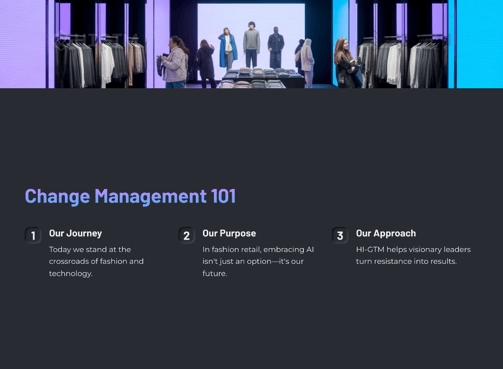

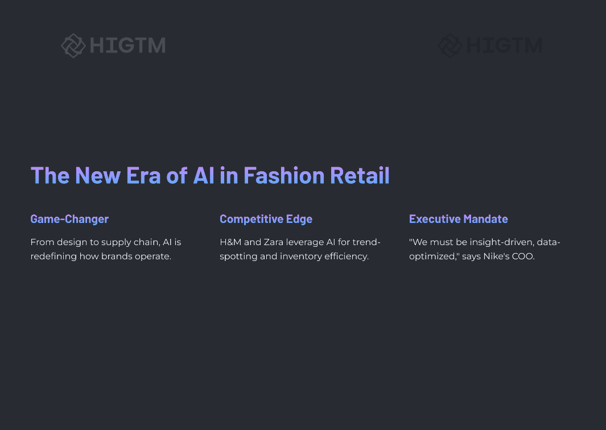

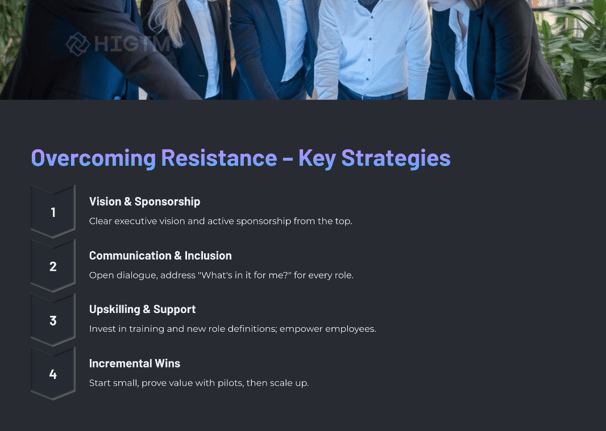

4. Strategy 2: Upskilling & Redefining Roles
4.1 Invest in Training and Education
A leading cause of resistance is the fear of inadequacy – employees worry they won’t have the skills to thrive in an AI-enabled workplace. The antidote is a robust investment in training and upskilling. Global fashion retailers have started treating training not as a one-time event but as an ongoing program. For example, when a U.S. apparel giant rolled out an AI-driven allocation system to determine how much stock each store should get, it set up a “Fashion Tech Academy.” Every allocation analyst and store planner attended hands-on workshops to learn the new system, with follow-up e-learning modules available for refreshers.
The company scheduled extra staff during the first few weeks of go-live so employees could take time to practice with the tool on the job. Additionally, training should cover not just how to use the AI, but also the why – the basic concepts of machine learning or analytics relevant to the tool. When people grasp, even at a high level, what the AI is doing and how their interaction makes it better, they feel more in control. This builds confidence. In the case of Macy’s digital transformation, the retailer recognized that ongoing training was crucial and made “comprehensive upskilling” a cornerstone of its change plan.
Beyond formal training, consider peer learning and mentoring: pair tech-savvy employees with those less comfortable for one-on-one guidance. The goal is to create a learning culture where asking questions is encouraged and resources are readily available. When employees feel the company is investing in their growth, they are more likely to invest their effort in the new technology.
4.2 Redefine Roles to Complement AI
Adopting AI in fashion retail often changes the nature of certain jobs. A critical change management step is to proactively redefine roles so that humans and AI complement each other, rather than compete. This is exactly what H&M did in their purchasing department. When AI took over the tedious task of allocating quantities for global buys, H&M redesigned the buyers’ roles to focus on strategic merchandising, trend curation, and analysis of AI output.
They even updated team names to reflect the new responsibilities, helping employees shed the old identity and embrace the new one. This approach sends a powerful signal: the company isn’t using AI to cut jobs in this case, but to elevate them. Employees move up the value chain – doing work that arguably is more interesting and impactful. Another example might be a luxury fashion retailer that introduces AI personalization for online customers.
The role of the marketing team shifts from manually segmenting email lists to curating creative campaigns that align with AI-generated customer clusters. In stores, if an AI clienteling app suggests items for a shopper, the sales associate’s role can be framed as a “stylist plus” – they use the suggestion as a starting point and then add their personal human touch to close the sale. The company could formally change the title from Sales Associate to “Client Advisor” to mark this evolution.
By redefining roles, you address the “am I being replaced?” fear with a narrative of “your role is becoming more important – here’s how.” It gives employees a new professional story where AI is a tool that makes their contribution more critical, not less. This strategy was successful at H&M, where post-redefinition, employees “felt empowered, regained a sense of competency, and invested in the use of AI”.
That’s the outcome you’re aiming for across the board.
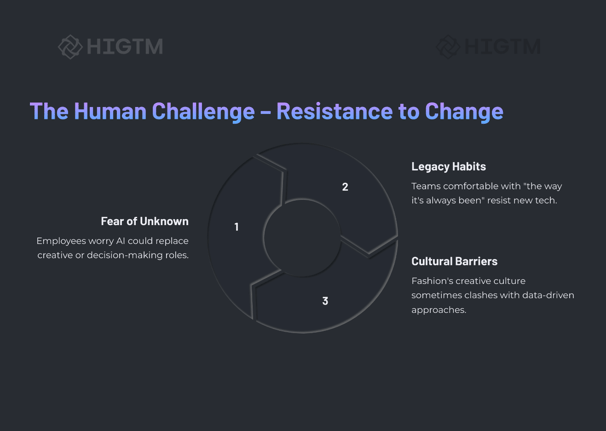

5. AI-Driven Alerts and Automated Decision-Making
One of the defining features of next-gen dashboards is the inclusion of AI alerts and automation, moving from merely descriptive dashboards to prescriptive and autonomous systems. In fashion retail, this can cover a lot of ground: from merchandising decisions to operational fixes, handled or suggested by AI in real time.
5.1 Anomaly Detection Alerts
AI excels at understanding what “normal” looks like in your data and flagging when something deviates sharply. Retailers set up anomaly detection on metrics like sales velocity, website traffic, average basket value, inventory variances, etc. For example, if a typical Wednesday sees $500k in sales by noon, but today it’s only $300k by noon, the AI will flag a potential issue – maybe a site glitch or a supply issue. Conversely, if a particular product is selling 5 times faster than usual (spike), it flags that too – a positive anomaly that still requires attention (ensure inventory can support it, investigate why it’s spiking – maybe an influencer mention). These alerts appear on dashboards as colored warnings or push notifications to relevant managers. The key is immediacy: rather than waiting for an end-of-day report or someone to notice, the AI is watching 24/7. Many retailers tie these alerts to mobile apps so on-duty managers get pinged. For mission-critical systems, an alert could even trigger a halt – e.g., anomaly detection on checkout errors might automatically page the IT team and switch the payment gateway if it suspects a problem. By addressing anomalies quickly, retailers prevent small issues from becoming big losses. For instance, catching a sudden conversion drop might reveal a promo code error that can be fixed in minutes, saving countless sales that would have been lost in hours of dysfunction.
5.2 Automated Price and Markdown Decisions
We touched on dynamic pricing; here we highlight how AI can automate it within bounds set by management. Fashion retailers often need to markdown items as they age to clear stock. AI can decide the optimal discount and timing based on real-time sales performance, inventory, and even weather (sunny weekend might increase store footfall, so maybe hold off markdown until next week if rain is expected). These decisions, once made by planners in meetings, can now happen daily. A dashboard might list items that AI marked down today along with rationale (e.g., “Item ABC: lowered price 15% – stock > 8 weeks cover, below target sales”). Some brands, especially in fast fashion, empower algorithms to run these micro-markdowns frequently to maximize sell-through and margin. This is done carefully to avoid brand damage, but when done right, it’s very effective in squeezing out more revenue. Mango, as an example (not in our list, but relevant industry peer), uses AI for markdown optimization – their system suggested price changes that improved sell-through with minimal margin sacrifice. In luxury, dynamic pricing is less used (brand value control), but even they use AI for localized pricing and inventory-driven adjustments (like identifying when to quietly offer a perk or free shipping on a high-end item that’s not selling in a particular region). All these AI decisions are reflected on dashboards for transparency and override if needed.
5.3 Inventory Allocation & Transfer Automation
In supply chain, AI can decide how to distribute products across various warehouses or stores. Historically, allocation was done pre-season with little adjustment. Now, as data comes in, AI might say: “We expected Dress X to sell evenly, but it’s selling more in urban stores than suburban. Let’s re-route remaining stock accordingly.” This can be automated: transfer orders get created and appear on the logistics dashboard. JD.com’s award-winning inventory optimization algorithm is a case in point – it integrates demand forecasting and iterative optimization to continually deliver allocation plans that maximize product availability with minimal cost.
The system gives clear insights and also essentially runs the allocation show, which contributed to JD fulfilling 90% of orders within 24 hours.
In practice, for a fashion retailer, this might mean an AI suggests or automatically moves stock between stores when one store has excess and another is selling out. The dashboard would highlight these transfers and their outcomes (e.g., how many potential lost sales were saved by the move). This also extends to automated replenishment from central to stores: AI decides the quantities each store gets in the next shipment, not just based on a fixed plan but the latest trends. It’s a rolling, ever-adjusting process – essentially real-time allocation versus set-it-and-forget-it.
5.4 Customer Engagement Automation
On the customer side, AI chatbots and personalized marketing can be triggered automatically by dashboard events. For example, if a customer is browsing for 10 minutes appearing indecisive, an AI chatbot might proactively pop up to assist (increasing conversion chances). If a high-value customer hasn’t purchased in a while, an AI-driven campaign might send them a personalized offer – and this trigger could be a rule on the CRM dashboard. LVMH implemented a sophisticated internal AI called MaIA to help support staff with content and customer queries.
While that’s more for internal use, customer-facing AIs like chatbots are widely used by fashion retailers to handle common queries (order status, return policy, product info) instantly. The real-time aspect is that these bots are “on” 24/7, and their performance (# of queries solved, CSAT scores) shows up on service dashboards continuously. If the bot encounters something it can’t handle (negative sentiment or complex issue), it can alert a human agent to step in – blending AI efficiency with human touch at the right moment. Retailers also use AI for real-time content personalization: banners on the website changing to show a category a user has shown interest in, or emails triggered by actions (abandoned cart, browse abandonment) that are completely automated. The coordination of these is visible to marketing teams via dashboards (so they don’t accidentally overlap communications or over-contact). Essentially, the AI is doing multi-tasking that a whole team of marketers and service reps might do manually, and the dashboard is where it’s orchestrated and supervised.
5.5 Continuous Learning & KPI Optimization
A powerful advantage of AI is that it can learn from new data. The models driving all the above (forecasting, recommendations, anomaly thresholds, etc.) get better over time by training on the latest info. The dashboard often includes tracking of model accuracy or impact. For instance, a forecast accuracy KPI might show it improved from 85% to 90% after the latest algorithm update – demonstrating learning.
Some retailers even deploy AI A/B tests and show results on dashboards: e.g., one algorithm vs another for recommendations – which yields higher revenue per user? Based on the live experiment, the better model is chosen. Over a year, this iterative approach might significantly elevate performance benchmarks. One concrete example is in pricing: an AI might start with a rule-based approach, learn price elasticity from data, and evolve into a more nuanced model that yields higher margins. The dashboard closes the loop by displaying the key outcome metrics that these models aim to improve (sales, margin, sell-through, NPS, etc.), so it’s always clear whether the AI is adding value. If not, tweaks are made.
Retailers like Stitch Fix (though not listed, known for AI) famously use algorithms in many decisions and constantly refine them. Traditional retailers are catching up, embedding AI to assist merchants and planners. The phrase “Quiet AI” used by LVMH’s CDAO refers to AI subtly advising human decision-makers without being intrusive – for example, a suggestion in the dashboard “This bag is trending in Asia, consider reallocating stock.” The human can review and approve, but the suggestion comes from data. This hybrid approach is becoming common: AI does the heavy analysis and proposes actions; humans oversee brand alignment and final calls.
Key Takeaway: AI-driven dashboards don’t just inform you about what is happening; they increasingly decide what to do about it, or at least give you a very strong nudge. By automating routine decisions and highlighting urgent exceptions, they free up human managers to focus on strategy and creativity. The result is a business that’s not only always aware, but always acting and adjusting – a living, breathing operation tuned to the market in real time. Fashion is an industry of constant change, and AI automation ensures the company changes in sync with the market, not behind it.
6. Strategy 4: Start Small – Pilot and Scale
6.1 Pilot Projects as Learning Labs
Big transformations can feel overwhelming. That’s why savvy change leaders use pilot projects to break the challenge into manageable pieces. A pilot is a trial run of an AI initiative in a controlled environment – a few stores, a single brand in a portfolio, or one department – before a wider rollout. Pilots serve multiple purposes: they provide proof of concept, work out kinks, and create success stories to win over skeptics. For example, Inditex (Zara’s parent company) might pilot a new AI-driven markdown optimization algorithm in one region’s stores. During this phase, they closely track results (did it increase sell-through? How did store managers feel about it?), gather feedback, and refine the system. If an aspect of the AI suggestions wasn’t practical (say, recommending markdowns on a timeline that clashed with store hours or staff availability), the company adjusts the process. This learning is invaluable and can prevent costly mistakes in a full rollout. Pilots also limit risk – if it doesn’t go well, the impact is contained and doesn’t throw the whole company into chaos. From a change management perspective, choosing the right pilot team is key. Ideally, pick a mix of tech-savvy enthusiasts and open-minded skeptics (to get balanced feedback), and ensure they get extra support and recognition. When the pilot yields positive results, celebrate them widely. The success provides a “see, this works!” moment to share with the rest of the organization. It’s much easier to convince a resistant department to try the AI when you can point to a similar team that used it and thrived. Step by step, pilot by pilot, the organization builds confidence and competence in using AI.
6.2 Scale Up with Iteration
After a successful pilot, the challenge is to scale up while keeping the momentum and not spooking the broader workforce. This is where an iterative, phased approach comes in. Rather than immediately deploying the AI solution everywhere, consider a phased rollout – for instance, expand from the pilot stores to an entire region, then to all regions. At each step, apply the lessons learned from the prior phase and be ready to adapt.
Change management activities should also scale accordingly: continue communications campaigns during each phase, perhaps with newsletters sharing stories from pilot users (“Employee X from our Milan store said the new app saved her 5 hours a week on inventory counts – here’s how…”). Also, anticipate that new resistance might pop up in later phases among people who weren’t involved early.
Address their concerns with the credibility you’ve gained. Now you have concrete data and testimonials to handle doubts. Keep training ongoing as you scale – don’t assume that because one group was trained and loved it, the next group will pick it up instantly. Sometimes scaling reveals new challenges, like integration issues with other systems or capacity strains (for example, an AI system that worked with 10 users might slow down with 1000 users). Be transparent about these bumps and proactive in resolving them – it shows a commitment to getting it right, which reassures users that they’re not being forced onto a sinking ship.
A phased approach also ties back to building a culture of continuous improvement. It demonstrates that the company is learning and evolving, not blindly pushing a top-down mandate. Over time, as more employees touch the AI and see its benefits, resistance diminishes and using the new tools becomes the norm. Essentially, you’re turning early adopters into champions, and late adopters into followers, steadily moving the whole organization into the future state.
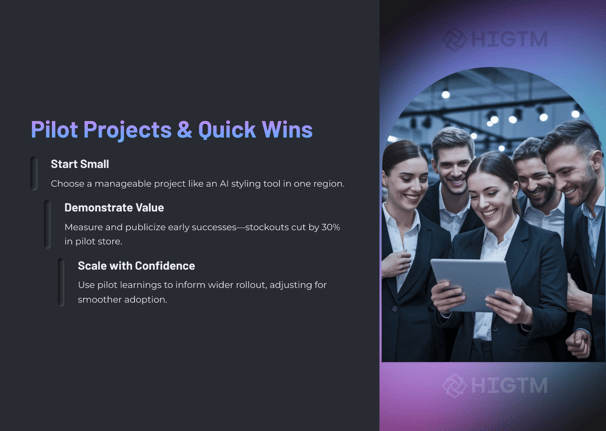

7. Real-World Examples: Fashion Brands Leading the Way
7.1 H&M Group – From Pushback to Pacesetter
Case: H&M, one of the world’s largest fashion retailers, faced internal resistance when it first attempted to use AI for decision-making in purchasing and inventory. Seasoned buyers feared that algorithmic forecasts would override their market experience and intuition. Indeed, at first the buying team’s resistance was strong enough to hinder the project.
Change Management Actions: H&M leadership took a thoughtful approach. They openly addressed the team’s concerns and clarified that the AI system was there to eliminate tedious manual tasks (like analyzing hundreds of spreadsheets), not to invalidate the buyers’ expertise.
The company redesigned roles so that buyers would spend less time calculating and more time strategizing – for example, deciding how to use AI insights to shape more appealing collections.
To reinforce this, H&M even changed team titles, giving a sense of fresh start and importance to the new way of working. They also provided training on the AI tools and allowed the buying team to have final say if something looked off, giving them confidence that their judgment was still paramount.
Outcome: Over time, this method paid off. The buyers began to see the AI not as a threat but as a helpful assistant. Routine tasks that took days were done in hours, freeing them to focus on creative merchandising and supplier strategy. The Fortune/BCG report notes that H&M employees eventually “felt empowered, regained a sense of competency, and invested in the use of AI”.
H&M’s successful navigation from resistance to acceptance turned it into a pacesetter for AI-driven retail, with efficient logistics and even AI-driven customer service bots now part of its operations. The key takeaway is how H&M turned dissenters into believers by reframing jobs and building trust.
7.2 Nike – Cultural Shift to Digital
Case: Nike, the American sportswear giant, embarked on a major digital transformation in the mid-2010s, which included AI investments in personalized marketing, demand sensing, and inventory optimization. Nike’s challenge was less about specific tool pushback and more about orchestrating a broad culture shift across a huge organization traditionally oriented around product and brand marketing. Moving to a truly data-driven, direct-to-consumer model required every part of the company to work differently.
Change Management Actions: Nike’s leadership set the tone from the top. The company launched the “Consumer Direct Offense” – essentially a rallying cry that put digital and data at the center of its strategy. To make this vision concrete, they restructured parts of the organization (e.g., creating the Nike Direct division focused on online and apps) and invested heavily in talent by acquiring tech startups (like Celect for AI and analytics) and hiring analytics experts. But they didn’t stop at structure; Nike also worked internally to evangelize the benefits of this shift.
Executives frequently highlighted data success stories in town halls – for example, how leveraging AI improved a product launch’s sell-through or how predictive analytics informed design tweaks that became top sellers. They encouraged a mindset of “acting like a tech company” through internal programs and training, teaching traditional retail staff about agile methods and data interpretation. Importantly, Nike leadership maintained consistent messaging: as COO Eric Sprunk said, “We must be insight-driven, data-optimized…” – reinforcing that this was the new normal for Nike’s culture.
Outcome: Nike’s concerted efforts paid off. Within a couple of years, the company saw digital sales explode (30% of revenue by 2018), validating the approach. Employee acceptance grew as they witnessed the success; digital initiatives were not a passing fad but central to Nike’s growth (especially as seen during the COVID-19 pandemic when those digital channels carried the business). Nike essentially created an internal belief that “great product plus great data equals great results.” Today, Nike continues to be viewed as a leader in marrying tech with retail – a feat made possible by top-down vision and comprehensive change management that won hearts and minds across the swoosh.
7.3 Inditex (Zara) – Agile Adoption through Culture
Case: Inditex, the parent of Zara, is renowned for its fast-fashion prowess. The company has been steadily infusing AI into various parts of its business – from using AI-driven trend forecasting to decide new designs, to implementing advanced inventory systems with RFID and robots for logistics.
Inditex’s challenge was to implement these cutting-edge tools without slowing down its famously agile operations. Could a company built on quick decision cycles and human judgment integrate AI smoothly?
Change Management Actions: A big part of Inditex’s success lies in its corporate culture. Since the days of founder Amancio Ortega, Zara’s ethos has been about ceaseless innovation and adaptability. This cultural readiness meant employees somewhat expected continuous improvements and were less shocked by new tech. Nevertheless, Inditex took concrete steps.
They emphasized how each innovation improves employees’ daily work. For example, when introducing warehouse automation and AI, they highlighted that 500 new robots would “support the operators” and “bring the shelf to the worker”, reducing physical strain and improving safety.
By framing the AI as an aid to make jobs easier – not to eliminate jobs – they gained employee goodwill. Inditex also leverages extensive training, often in partnership with tech providers (e.g., workshops with the vendor’s experts on-site when RFID was launched). Another tactic is piloting tech in a few Zara stores that have a reputation for being experimental, then using those success stories to drive acceptance globally. Managers from pilot stores become trainers or advisors to other store managers – peer influence in action.
Outcome: Inditex has managed to roll out AI technologies at scale (across thousands of stores) relatively quickly. Inventory accuracy improved and stock-outs reduced, which employees noticed as less firefighting for them. Because the company’s structure empowers store managers and regional managers to adapt to their local market, giving them new AI insights actually enhanced their ability to make decisions, rather than replaced it. The uptake of new systems like the AI-driven store layout tool or customer insight analytics has been strong, keeping Inditex at the forefront. The lesson here is that a culture of agility and continuous improvement is perhaps the best foundation for embracing AI – Inditex treated each new tech like a fashion trend to incorporate, not a threat to avoid, and its employees followed suit.
7.4 Burberry – Pioneering Digital in Luxury
Case: Burberry, a British luxury brand with over 150 years of heritage, might not be the first name one associates with AI. Luxury companies have historically been cautious with digital, worried that tech could erode exclusivity. Yet Burberry bucked the trend, especially in the 2010s, by investing early in digital platforms, big data, and AI for marketing and customer engagement.
Their challenge was bringing a very traditional workforce and brand legacy into the digital age without losing the brand’s luxury feel.
Change Management Actions: Burberry’s transformation under former CEO Angela Ahrendts and then her successors was driven by a bold vision: to be the most digitally innovative luxury brand. They communicated a clear message that embracing technology was how to stay relevant to younger luxury consumers. To manage change, Burberry did a lot of internal storytelling. They shared data showing that a significant portion of their clientele engaged with the brand online and that 80% of luxury purchases were influenced by digital in some way.
This helped skeptical staff see that digital initiatives (like an AI-powered personalization engine or a chatbot on Facebook Messenger) were actually in service of the customer, not gimmicks. Burberry also invested in digital talent, creating mixed teams of fashion experts and tech experts, which helped cross-pollinate ideas internally. They introduced training for retail associates on using customer data tablets in-store to tailor recommendations – framing it as reviving the old personal shopper experience with a high-tech twist. Importantly, leadership maintained luxury’s high-touch ethos by ensuring AI outputs were always used to augment a human decision, not make it outright. This preserved the pride employees had in offering a premium service, while still utilizing the latest tools.
Outcome: Burberry’s efforts yielded concrete benefits. By 2015, they reported a 50% increase in repeat customers attributed to their data-driven personalization efforts.
Internally, Burberry transformed its image from a slow-moving classic label to a forward-thinking brand. Other luxury houses began to follow Burberry’s lead in digital. Employees became proud that Burberry was seen as an innovator. The brand’s successful tech experiments – like RFID tags in products that unlock multimedia content, or using AI to analyze sales patterns – were celebrated rather than resisted.
Burberry showed that even in a heritage brand, change management focused on educating people about why tech enhances luxury, plus providing the tools and training to use it, can overcome resistance. The company managed to keep its classic appeal while embracing 21st-century capabilities, largely thanks to aligning everyone on the need to continually delight a new generation of luxury buyers.
8. Conclusion: The retail fashion industry is undergoing a tech-driven evolution at a global scale.
AI technologies promise immense benefits – from hyper-efficient supply chains to personalized customer journeys – but realizing those benefits hinges on one factor: people. As we’ve seen, resistance to change is natural, especially when dealing with intelligent systems that alter how work gets done. However, with a proactive and empathetic change management strategy, fashion retailers can turn this resistance into a driving force for success. It starts with clear vision and leadership commitment, ensuring every team member understands the why behind the change.
It flourishes through open communication, involvement, and training, which together create a supportive environment where employees feel heard and prepared. Empowering staff – whether through preserving autonomy or redefining their roles to be more fulfilling – builds trust in AI as a helpful colleague rather than a threatening rival. Finally, patience and persistence via pilot programs and phased rollouts allow the organization to learn and adapt, making the transition smoother for all.
In a world where fast fashion meets fast data, the winners will be those companies that master not only the latest algorithms, but also the art of guiding their people through change. The case studies of H&M, Nike, Inditex, and Burberry prove that even the largest, most traditional organizations can successfully embrace AI when they put people at the center of the transformation. They have set the blueprint: blend technical innovation with human-centric leadership.
For corporate executives plotting their AI adoption journey, the message is clear – invest as much in change management as you do in the technology itself. Do this, and your organization will not only adopt AI; it will harness it to its full potential, with a workforce that’s engaged, confident, and future-ready. In the end, fashion retail has always been about anticipating the next trend. In this era, the next trend is change itself – and those who learn to manage change effectively will stitch the fabric of the future.
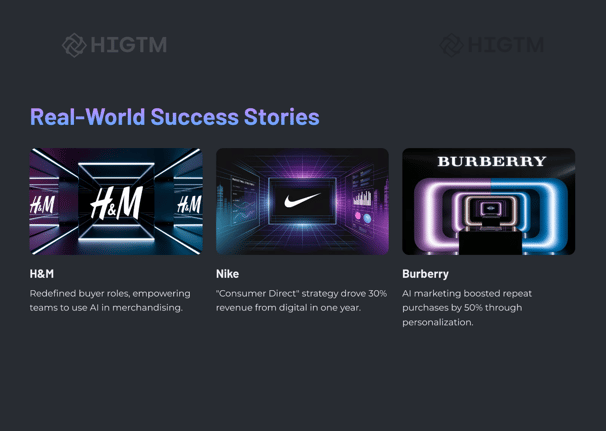

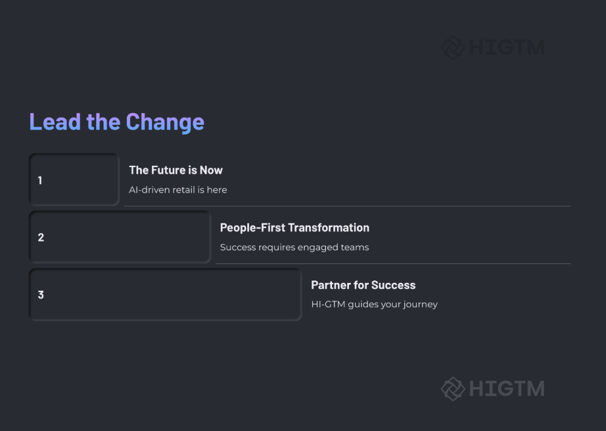

Turn AI into ROI — Win Faster with HIGTM.
Consult with us to discuss how to manage and grow your business operations with AI.
© 2025 HIGTM. All rights reserved.
